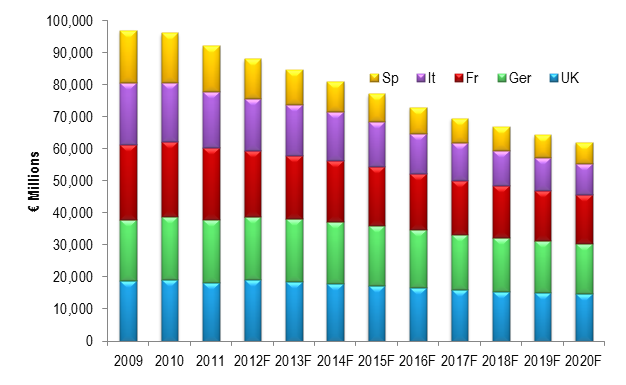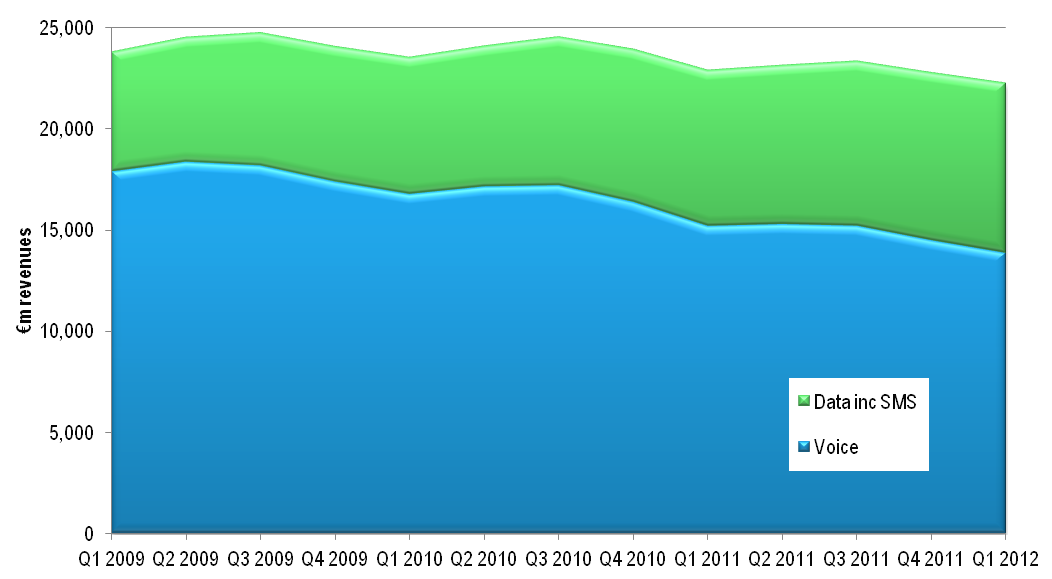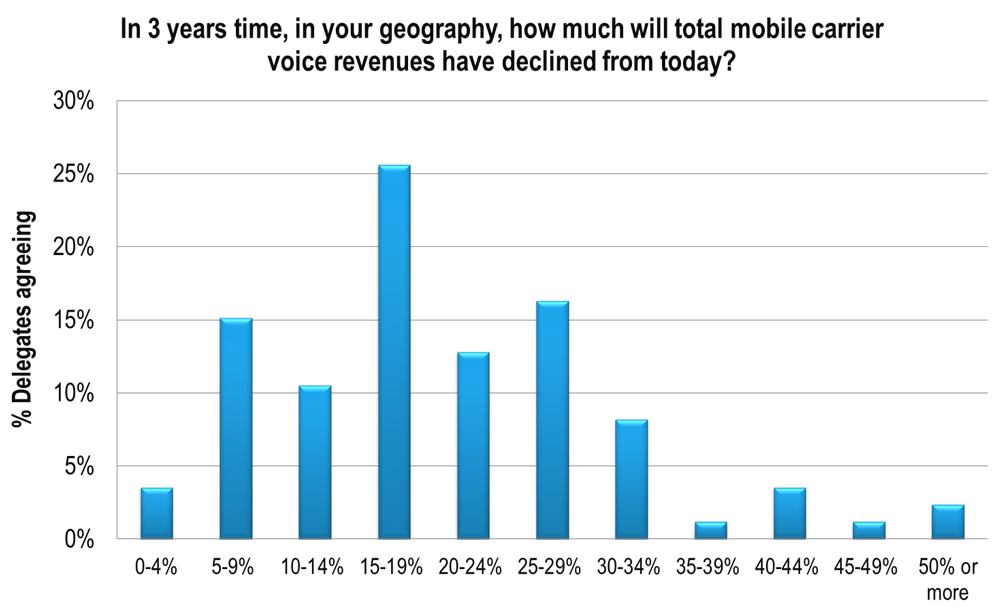Login to access
Want to subscribe?
This article is part of: Executive Briefing Service
To find out more about how to join or access this report please contact us
New analysis by the Telco 2.0 team shows that the mobile industry’s combined revenues from voice, messaging and data services in the EU5 economies (UK, France, Germany, Spain and Italy) will drop by nearly 20Bn Euros, or 4% per year, in the next five years, and by 30Bn Euros by 2020. (October 2012, Executive Briefing Service) Euro Voice Brutal Future October 2012
Summary findings and implications
Dark skies ahead
The mobile telecoms sector has performed quite strongly through the economic downturn but STL Partners’ forecast for UK, France, Germany, Spain and Italy suggests that the outlook is extremely bleak:
- Even in the UK and Germany, the markets with the brightest future, STL Partners forecasts a respective 19% and 20% decline in mobile core services (voice, messaging and data) revenues by 2020. The UK has less far to fall simply because the market has already contracted over the last 2-3 years whereas the German market has continued to grow.
- We forecast a decline of 34% in France over the same period.
- In Italy and, in particular, Spain we forecast a brutal declines of 47% and 61% respectively.
- Overall, STL Partners anticipates a reduction of 36% or €30 billion in core mobile service revenues by 2020. This equates to around €50 billion for Europe as a whole.
Figure 1: Mobile core Service revenues

Source: European regulators, Mobile operators, Barclays Capital, STL Partners assumptions and analysis
- Even if our forecasts prove to be too pessimistic – and we have sought to be realistic rather than unduly negative and have built our models bottom up looking at pricing and volume trends wherever possible – the future looks much worse than other analysts and industry observers are currently forecasting. For example, a recent report by Arthur D Little and Exane BNP Paribas forecasts a 2.3% per annum decline in mobile to 2015 compared with our forecast of 4.3% per annum decline over the same period.
- Data growth, service bundling, customer experience improvements and cost-cutting activities are valuable but fall way short of offsetting declines in voice and messaging. The game for mobile operators in Europe is changing forever: as things stand, in a few short years they will be forced to become very much more conservative businesses – more like gas and water companies. Interestingly, the capital markets already rate telecoms companies as utilities judging by their lofty dividend yields.
- There will be casualties. Several operators will not exist in their current form by 2020. Despite the desire of regulators to have four or five network operators in their countries to encourage competition, the downward revenue pressure will favour scale economies and the pressure for many operators to merge or acquire/be acquired will be overwhelming.
Get your umbrellas ready now
We are starting to see a few European operators invest more actively in building new revenue streams – something that STL Partners has been pushing through its Telco 2.0 initiative for several years. Telefonica with Telefonica Digital, KPN, Orange, Telenor and a handful of other companies are becoming more active in ‘digital services’ and new business models. This activity urgently needs to be accelerated and prioritised if operators stand any chance of replacing the impeding revenue declines.
For future success, operators must embrace Telco 2.0 (and recognise the need for a new business model and new service offerings) whether that is as a lean ‘Telco 2.0 Happy Pipe’ or as a ‘Telco 2.0 Services Provider’. Both of these strategies require business model transformation that encompasses:
- Major strategic choices and decisions about what the organisation should and should not do;
- The identification, selection and development of new products and services;
- More effective processes for bringing newly developed services to market;
- A realignment of organisation structures to deliver the new services;
- A redefinition of the way operators work with each other and with external partners to build value;
- Clarification of how technology should support the Telco 2.0 business model and services;
- A review of revenue and cost models to maximise value for consumers, partners and telcos themselves;
- A new relationship with regulators as the industry seeks to redefine its role and value in the digital economy.
STL Partners remains committed to working with TMT players that want to make the changes identified above in three ways:
- Research. We have recently published several reports that focus on what the industry should do and how it should do it including those within our Executive Briefing Service, the freely available How to accelerate new business models and two major new strategy reports, A Practical Guide to Implementing Telco 2.0, which outlines a step-by-step methodology for each of the 8 areas, and Cloud 2.0: Telco Strategies in the Cloud.
- Events. Our executive brainstorm events in London, Dubai, Singapore and Silicon Valley remain the best forum for senior executives to debate key strategic issues and develop their thinking.
- Consulting. We continue to undertake advisory work with operators, vendors and technology companies that seeking to transform their business models and pursue new opportunities.
For more details of how STL Partners can help you, please contact us.
Introduction
The telecoms industry is performing quite well in a tough economic environment
At the moment, the global telecoms industry seems to be in relatively robust health – developing economies are driving subscriber growth, 4G is being rolled out, smartphones are being connected with data plans in huge numbers, service providers are selling bundled “integrated offers” to maintain revenues, and costs are being controlled with network-sharing and other strategies
But there is also a nagging concern held by industry managers and observers that all is not well ‘below the waterline’, especially in mature markets. There have been a few worrying signs from operators losing out on messaging revenues to OTT players like WhatsApp, or suffering outright reductions in revenues and subscriber numbers in markets like Spain. That said, these have been largely ascribed to poor pricing decisions or (hopefully) temporary local macroeconomic problems.
Certainly, the financial markets seem pretty convinced in the operators’ underlying ability to turn consumers’ desire for communication into ARPU. Not only that, but there is broad conviction that growing data revenues should be able to offset – plus or minus a little – slow declines in voice and messaging, especially when it is all wrapped up in a bundle.
The question is whether that assumption is really valid, or whether there are broader structural risks, or even any reality in the dystopian view that revenues could suddenly ‘fall off a cliff’? Looking at the fixed telecom industry, it is notable that voice revenues have undergone a fairly precipitous decline over the past decade, partly because of mobile substitution, partly because of competition and, in some cases such as lucrative international calls, because of competition from Skype and its peers. Meanwhile, adjacent markets such as cable have started to suffer from the popularity of alternative sources of digital TV and content. Some of the fixed operators have picked up the slack with IT services and cloud infrastructure, but others have suffered – often to the extent that they have sold out, typically to their mobile peers.
But how bright is the future really?
Will mobile operators fare any better over the next 5-10 years? In developed markets, they have to contend with market saturation, increasing competition on basic services, and tightening regulatory regimes. They also need to deal with the strategic issue of the internet-based app ecosystems such as Apple’s and Google’s, and OTT-type services from the likes of Facebook and Microsoft/Skype. There is also a possibility that the very nature of ‘core services’ like telephony might change, as voice communications starts to get embedded into apps and the web itself. Some observers even see our 100-year relationship with voice telephony diminishing in importance, as other forms of communication become more useful.
This report looks into the mobile marketplace – specifically, voice and messaging services in the main European countries. We have constructed a “what if?” scenario model, that takes some basic assumptions about voice usage and pricing, along with data revenues trends. Rather than just assuming that ARPU will remain broadly flat and then divide it up between voice and data, we’ve started looking from the bottom up. Can likely declines in voice revenues really be made up elsewhere, especially given the possible collapse of SMS and the commoditisation of mobile data? Just how big might the gap be that needs to be filled with ‘other services’ such as content resale, two-sided capability exposure, M2M, vertical industries or Telco-OTT propositions?
Taking together the five largest European mobile markets – Germany, France, UK, Italy and Spain – paints a picture that should cause some alarm. Despite the rise of smartphones and dongles, overall quarterly mobile revenues are down 10% on their peak from Q3 2009; falling from €24.7bn to €22.2bn in Q1 2012. Even accounting for seasonality, this is significant (a €10bn annualised shortfall) – and early results suggest the fall accelerated in Q2 2012, as economic and competitive factors bit deeper into sales, with recessions in several countries and new entrants such as Free in France.
Worse, if we just look at voice revenues, the market is now down 25% from its peak in Q2 2009, and that fall seems to be accelerating. While declining voice ARPU is not a huge surprise, the failure of other services to take up the slack is disappointing, especially as the source of new business – basic data connectivity – also is the most capex-hungry in terms of extra costs of new spectrum and 3G/4G build-out.
Figure 2: EU5 Mobile Services revenue already down 10% from 2009 peak

A set of cold-blooded forecasts for UK, France, Germany, Italy and Spain
To the best of our knowledge, nobody else has made forecasts that are both dispassionate and founded on hard data and bottom-up analysis.
Too many analyst (and we suspect internal) financial models seem to suggest that ‘It’ll be alright, somehow… telecoms operators need to harvest cash from voice and messaging, grow data and find some new revenues, but there’s plenty of options’. STL Partners is questioning the first and second premises in the statement above – about harvesting voice and messaging and growing broadband data – not because we’re pessimists, but because we think that many in the industry are not acknowledging the scale of the problems ahead and making the necessary (and often uncomfortable) decisions early enough.
Views vary widely on the outlook for mobile telecoms in Europe
It is fair to say that the fixed telecoms industry has undergone enough pain over the last decade to be under no illusions about its challenges. Operators realise that they face a continued hard slog against competition, regulation, content providers and indifferent consumers. They have increasingly focused on businesses, wholesale models and specific high-value niches like fibre-based triple-play. Deployment of FTTC/FTTH has been patchy, as they have realised that political support doesn’t equate to revenue uplift or return on capital.
Conversely, the mobile industry has pinned its hopes on LTE, data services and various collaboration and partnership business models. Some operators have essentially become Apple and Samsung resellers, offering credit-finance for expensive devices in the guise of handset subsidies. Plenty of other ideas, from mobile money to M2M to API exposure have been the subject of huge efforts. As yet, none has really moved the needle compared to the legacy telephony and SMS services that still make up a large (60%+) share of most operators’ top line revenues. The only bright spot has been plain-vanilla Internet access, initially with 3G dongle modems for PCs, and more recently for smartphone data plans. But the former has now gone largely ex-growth (thankfully, in some cases, given the traffic loads generated at low prices). And the latter faces growth challenges once most users have shifted to a smart device, as few users seem incentivised to upgrade to larger data plans so far.
Privately held view seems to be pessimistic…
In private discussions with operator executives, we encounter a fair level of pessimism, especially about voice and SMS revenues. At our conferences, we have asked senior executives (using our anonymised voting system) about possible price and value erosion, and are often surprised by how far and fast telcos seem to think these core services will dwindle.
Figure 3: Example Telco 2.0 delegate view of 3-year voice revenue decline

…yet publicly, there is much less acknowledgement of the scale of the issue.
We’ve seen investment banks’ forecasts that assume that ARPUs can be (mostly) maintained through the magic of bundling, while some operators themselves paint a picture that can, charitably, be seen as rose-tinted at best:
Figure 4: Orange remains optimistic about European telecoms revenues

Contents:
- The bundling paradox
- General trends impacting core services revenues
- Macro-economic issues
- Competitive & regulatory price pressure
- The declining demand for voice telephony
- Data growth
- The relative mix of pre-paid vs post-paid customers
- Lower handset subsidies
- Definitions, assumptions & methodology
- UK
- Germany
- France
- Italy
- Spain
- Europe-wide summary
- Appendix – Benchmarking prices for core services
- Figure 1 – Mobile core Service revenues
- Figure 2 – EU5 Mobile Services revenue already down 10% from 2009 peak
- Figure 3 – Example Telco 2.0 delegate view of 3-year voice revenue decline
- Figure 4 – Orange remains optimistic about European telecoms revenues
- Figure 5 – Vodafone view bundling as the way to stem revenue loss
- Figure 6 – At least 4 of the 6 general trends that impact mobile core services revenues are negative
- Figure 7 – Developed-market mobile pricing has dropped 10%+ per annum
- Figure 8 – French, German and Spanish mobile voice has historically had higher prices than other European countries
- Figure 9 – STL Partners recent analysis suggests that Spain’s voice prices are nearly double those of UK and France
- Figure 10 – Spanish voice premium is not offset by materially cheaper data charges compared with other European markets
- Figure 11 – Despite growth over 2005-2010 period, mobile voice volumes are now flattening in more mature markets
- Figure 12 – The underlying decline in fixed voice minutes (excluding mobile substitution) appears to be around 2% per quarter in the UK
- Figure 13 – Smartphone penetration of mobile user base, January 2012
- Figure 14 – EU5 mobile data revenues have grown steadily, not exponentially – and show recent signs of flattening-off as SMS declines
- Figure 15 – The UK has shown a steady decline mobile data revenue growth rate despite increases in dongles and smartphones
- Figure 16 – UK Mobile voice volumes (billions of minutes)
- Figure 17 – UK Baseline Mobile Revenues down 25% from 2011 levels by 2020
- Figure 18 – Unlike the UK, Germany mobile voice traffic is still growing strongly…
- Figure 19 – …and mobile data usage in Germany is exploding (from a low base)
- Figure 20 – Price pressure has meant that German mobile revenues have been flat in the recent past
- Figure 21 – Germany Baseline Mobile Revenues down 18% from 2009 levels by 2020
- Figure 22 – French mobile telephony volumes are still rising
- Figure 23 – SMS and mobile data traffic volumes growing strongly
- Figure 24 – France Baseline Mobile Revenues down 35% from 2009 levels by 2020
- Figure 25 – Italy Baseline Mobile Revenues down 46% from 2009 levels by 2020
- Figure 26 – Spain has been hurt especially hard by WhatsApp
- Figure 27 – Spanish mobile voice traffic has been flat, but now faces decline
- Figure 28 – The Spanish mobile market will fall precipitously through to 2020
- Figure 29 – Total EU5 mobile core services revenues will fall 38% from peak by 2020
- Figure 30 – Spain and Italy, in particular, are likely to experience a major decline in core mobile services revenues
- Figure 31 – Mobile Voice Telephony Revenue Forecast by Country 2012-2020
- Figure 32 – Extract from STL Partners database of 30-day SIM-only bundles
- Figure 33 – Extract of how unit prices were calculated by STL Partners